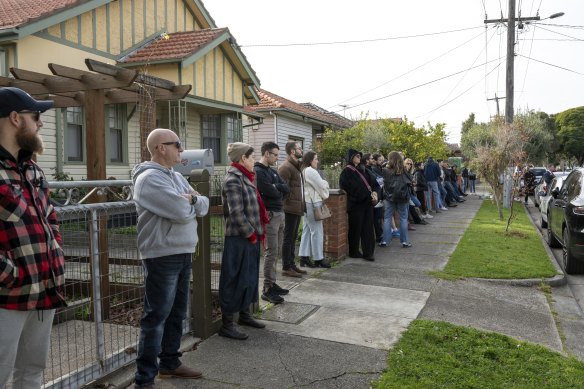This was published 4 months ago
‘Under pressure’: Why more home owners are selling properties now
Property owners struggling under the weight of 13 interest rate rises are more likely to list their homes for urgent sale than a year ago in the two largest states.
The number of homes for sale classified as distressed listings was 16.3 per cent higher in NSW in June than a year earlier, while the number in Victoria rose 15.6 per cent, figures from SQM Research found.

Home owners have been hit by 13 interest rate rises.Credit: Penny Stephens
Distressed listings are homes for sale marked with phrases such as “urgent sale” or “must sell” or “price reduced”.
The increase was in contrast to Queensland, Western Australia and South Australia where local property markets have been stronger and the number of distressed listings fell over the past year, contributing to a national fall.
Although home owners have been hit by rising mortgage repayments and the rising cost of living over the past two years, SQM Research managing director Louis Christopher noted that the volume of distressed sellers is not yet back to its pre-pandemic levels.
“The numbers are well and truly below pre-COVID levels, so we’re not overly concerned at this stage,” he said, although he noted Melbourne has been in a clear rising trend lately.
“It’s probably the greatest amount of stress they’ve experienced in the past 10 years, given where interest rates are, the rise in the cost of living that’s occurred … Many home owners have been under pressure.”
But he said although an increased number of owners are forced to sell, many others are not yet at that point as they have been able to cut back on discretionary spending, keep their jobs and perhaps even get a pay rise.
“We would definitely see a major rise in these numbers if the unemployment rate were to rise above 6 per cent and stay there,” he said.
The figures come as the number of home owners choosing to sell is also on the rise, and new listings are 6.7 per cent higher than a year ago in Sydney, and 9.8 per cent higher in Melbourne.
“They may well be listing because of increased uncertainty – uncertainty around what interest rates are likely to do, uncertainty around what the economy will do,” he said.
“[Owners think] ‘If we don’t list now, prices may fall in six months’ time, this might be the best price we can achieve.’”
He said the pick-up in sellers could return the market to more normal levels, after there being little for sale over the past few years, and offer more choice to buyers, but he did not believe that there were so many homes for sale it would push prices lower.
Commonwealth Bank head of Australian economics Gareth Aird said the longer interest rates have remained high, the more households have found it difficult to meet their mortgage repayments.

More homes for sale means more choices for buyers.Credit: Steven Siewert
He said there had been a gradual uptick in mortgage arrears, albeit still at low levels.
“Households are trying to do everything they can not to have to sell a place, given the cost of re-entering [the market] now is very high because you’ve got to pay stamp duty again,” he said.
“You’re seeing households cut back on expenditure … households looking for additional hours of work, a second member of the household going into the labour market.
“The number of people working multiple jobs is at a record high, so people are doing whatever they can not to sell.”
Others may rent out a room, or move back in with their parents and rent out their property.
He said the outlook for distressed listings would depend on the jobs market because if most owners kept their jobs they would be unlikely to need to sell their home.
RateCity research director Sally Tindall compared the rate of distressed selling with the pattern of home owners a couple of months behind on their mortgages, which has been rising but remains at lower levels than in 2019.
“Borrowers have thrown every effort into keeping up their mortgage repayments and making sure they’re paying on time, even though their mortgage rates have shot up,” she said.
She said many home owners have been refinancing their debt or haggling with their bank to reduce their repayments as much as possible.
Although tax cuts have started to hit bank accounts this month and energy bill rebates will begin soon, Tindall did not think there would be relief from high interest rates for some time.
She warned home owners to prepare for what may be the best part of another year of high interest rates and potentially one or two more hikes before any cuts. Even then, she suggested caution about baking rate relief into a household budget.
“There’s no guarantee your bank will pass them on in full,” she said.